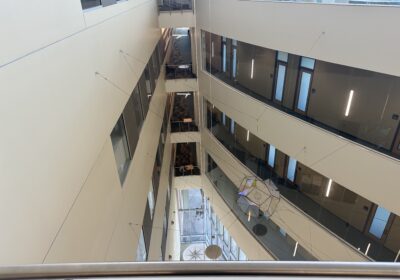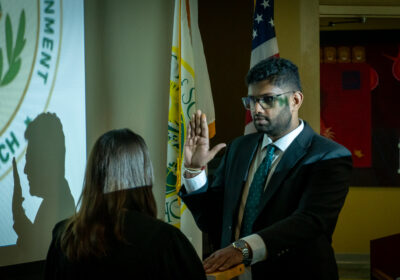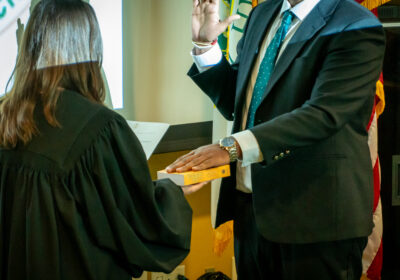‘The face of face blindness’

SPECIAL TO THE ORACLE
On a daily basis, USF professor Heather Sellers stands in front of a class full of students, unable to tell the difference between any of their faces.
Sellers has a condition known as prosopagnosia, or face blindness, which impairs her ability to recognize faces. Her vision is perfectly normal, however she is unable to discriminate between faces and store unique facial characteristics in her memory.
Recounting her experiences in her book “You Don’t Look Like Anyone I Know,” which was a New York Times Book Review Editor’s Choice and was featured in Oprah’s Book Club, Sellers described recognizing her disorder in her mid-30s.
For those unaffected by the disorder, it’s often difficult to comprehend what a face-blind person sees when they look at someone.
When the human face is turned upside down, the features become virtually indistinguishable. So, while it’s not difficult to identify facial features, it becomes impossible to store a face in memory because they are all identical.
“I was reading an intro to psych book and researching my mother’s paranoid schizophrenia, and what it was talking about was how schizophrenics have difficulty recognizing emotion on faces and there was just one sentence that mentioned that some people have face recognition problems and it was like the heavens were open and rays of light came down and a choir of angels,” Sellers said.
Sellers, who has an extreme case of prosopagnosia, went to a doctor in her small Michigan town in September 2005 and was turned away, told there was nothing wrong with her.
Determined, she went to a bigger town the next month only to receive the same response.
In December of the same year, Sellers traveled to Cambridge as part of a research study being done at Harvard, where she was finally diagnosed as a prosopagnosic individual.
“Back then, they still thought it was extremely rare,” she said. “Research was just coming out that it only affects 2 percent of the population and 1 in 50 people are affected to some degree.”
There are two different types of prosopagnosia: acquired prosopagnosia, which occurs following brain damage in an individual who had no facial-recognition issues prior, and developmental prosopagnosia, which is a result of a failure in development of the brain mechanisms necessary for facial recognition.
“We take for granted all of this stuff like recognizing a face and it’s automatic,” Sellers said. You can’t not recognize a face, it’s like blinking: it happens instantaneously. I have to work out by hand all of these steps to identify a person based on all of this other stuff. It’s not automatic, I have to work at it.”
Having already published several books including fiction, non-fiction and poetry, Sellers knew she would write a book about her experiences and actualization of prosopagnosia and began taking notes from the beginning.
“People are really interested in understanding, not just the bizarre condition, but it’s just interesting to see how you yourself view the world because you’re doing all of this stuff that you take for granted and I think that’s partly why people are interested,” she said. “I mean, the freakshow part is part of it, but I think we’re all trying to figure out who we are and how we see the world.”
This interest that everyone seems to have in her widely misunderstood condition brought a lot of attention to the book, landing Sellers a spot on “Good Morning America,” “Dateline” and “NBC Nightly News.”
Following all of the publicity, a close friend of Sellers’ jokingly deemed her “the face of face blindness.”
While she found success in telling her story, the road to getting there was not without bumps and dead ends. Growing up, Sellers often felt socially isolated from her peers, who viewed her as stuck up or shy, so she found friendship on the fringes.
“The kid in the wheelchair, the guy who was almost 7 feet tall, those were my friend,” she said. “I just see that as such a gift … I was attracted to the people on the edges and they always have more to say because they’ve been watching and listening and they’ve been through something.”
Once diagnosed, the problems didn’t end there. Sellers once called the police on her husband while he was working on the roof because she mistook him for an intruder.
But there was a defining moment that made her realize it was time to come out as face blind.
One afternoon, Sellers met her best friend and colleague from a previous institution for lunch at a restaurant. Her friend had just come from a frustrating meeting with school officials that she was venting to her about. When her friend got up and turned around, she swelled with embarrassment as the officials had been sitting behind them the entire time.
“How could you not tell me they were sitting there, Heather?” her friend said.
After that day, Sellers worked with a psychologist to write a letter to send to all of the students, faculty and staff at her institution, informing them of her disorder and asking them for help.
“It was hard for people who have known me for a long time,” she said. “I think they felt betrayed, they were just like, ‘How could you not have told me about this before,’ and I didn’t know I had it before.”
Sellers was very frustrated with the lack of understanding she experienced and turned to an online support group for advice.
After voicing her irritations, a woman named Nancy gave her some advice that Sellers needed to hear: “Heather, it took you 36 years to figure it out, why don’t you give people a little more time.”
Though there were a lot of initial questions, she found most people were very accommodating with time and were more interested in understanding what she needed from them.
Since coming to USF, Sellers said she has experienced nothing but accommodation and support from students and colleagues. As she passes out the syllabus on the first day of each semester, she explains her condition and that each student must wear a name tag every day because that’s the easiest way for her to identify them.
Because she is unable to recognize and retain faces in her memory, she has learned to identify those close to her by their gait and wardrobe, but it has proven to be unreliable. In one particular situation, she put her arms around a man she didn’t know in the grocery store thinking it was her husband.
Sellers and many other prosopagnosics share an interesting ability that many assume they’re incapable of: determining beauty.
After diagnosis, she went to Harvard where she was handed a stack of 50 faces and asked to place them in order from least attractive to most attractive, which she accomplished successfully.
But it’s not uncommon for face-blind individuals to experience other types of processing impairments.
“Sometimes prosopagnosia occurs in a very pure form, so people have problems with face recognition but they’re good with other sorts of visual recognition,” said Brad Duchaine, a researcher at Harvard who has worked with Sellers. “Some people have issues with objects, so they might have issues finding their car in the parking lot.”
Sellers is one of the face-blind individuals that has difficulty differentiating between cars, prompting her to buy a bright orange Honda Element that she lovingly refers to as the “pumpkin.” Also, like many face-blind people she can’t distinguish voices, making it difficult for her to speak on the phone.
Researchers have told Sellers there may be a cure for prosopagnosia within the next five years.
While she reserves the right to change her mind, she doesn’t believe she’ll take the cure.
“I’m so grateful for this disorder; it’s changed my life,” she said. “This is the irony: the disorder that made me so isolated for most of my life is now the vehicle by which I connect to people and without it, I don’t know how I would know people in that deeper way.”






